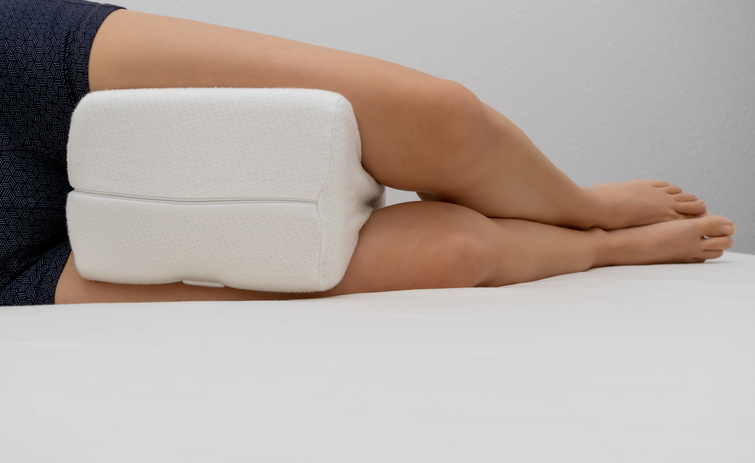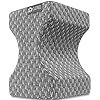By Nancy Alexander, PT, CSCS
Ever toss and turn at night trying to get comfortable? Does your back bother you? Do you experience hip or knee pain when you try to rest? Whether it happens only occasionally or more frequently than that, a knee pillow might be the answer to a good night’s sleep. If you know you know. In fact, you might be amazed at how good you feel after just one night.
There are other pillows out there, including the pillow you use for your head. There are smaller pillows, too, like toddler’s pillows. There are small ones, large ones, and longer ones. A full-length pillow is typically called a body pillow and can help improve the position of your upper body as well. Sure, these pillows might work for you but there are advantages to a specially designed knee pillow. We’ll take a closer look at what a knee pillow is, why you might want to use one, and how to choose the best one for you.

“The use of a pillow between your knees can improve overall comfort in bed,” according to the Sleep Foundation. “In particular, these pillows can help relieve pressure on the knees themselves. They can also help keep the spine, hips, and pelvis in alignment, which is particularly useful for those who experience back pain. Side sleepers and pregnant people generally benefit the most from the use of a knee pillow, which can help them feel supported and comfortable while sleeping.”
What exactly does a knee pillow do for you? According to “Do Knee Pillows Really Help?” from Bone & Joint:
- Placing a pillow between your knees helps you stay in the correct sleeping posture.
- Pillows keep your knees, hips, and spine aligned, which helps reduce stress on your hips, neck, and back.
- Sleeping with a pillow between your knees can help reduce cramps and morning stiffness.
- Side sleeping with a pillow between your legs can help keep airways open and can reduce the incidence of sleep apnea.
- Sleeping with a body or knee pillow can improve the circulation in your arms and legs, and even help prevent varicose veins.
From a musculoskeletal standpoint, a knee pillow can help you in the following ways:
- Reduce knee pain
- Reduce back pain
- Reduce hip pain
- Reduce buttock pain
- Reduce sciatica pain
- Reduce herniated disc pain
It’s all about correcting postural alignment. According to Daniel Yetman for Healthline, “Putting a pillow between your legs keeps your pelvis neutral and prevents your spine from rotating during the night. Maintaining good alignment can relieve some of the stress from the tissues in your back and may potentially reduce pain caused by a herniated disc or sciatica.” Some use a knee pillow each and every night, regardless of the presence of symptoms like pain. Some use it only during a flare-up of symptoms or after an injury. Simply put, if it helps you, use it.
There are various types of pillows to choose from as noted above so how do you know what kind to use? Bone & Joint suggests you consider the following:
- Many contoured knee pillows are made of memory foam, allowing the pillow to form to the shape of your knees. Some people like the smaller pillow’s portability. Others find the smaller size irritating and hard to keep in place while tossing and turning during the night.
- Other people appreciate the lower leg support afforded by regular-sized pillows. The larger size also stays in place better. Regular-size or king-size pillows separate both the knees and lower legs. Using a down-filled pillow or a down-alternative version allows the sleeper to adjust the pillow and achieve maximum comfort and support.
- Some people prefer the full-length support provided by a body pillow. When used correctly, a full-size body pillow provides support for the lower legs, knees, hips, and arms.

Knee Pillow from Amazon.com
No matter what type you choose, it should be firm enough to separate the knees and keep the hips aligned. A knee pillow is best at that. Some knee pillows also have straps which some say helps to keep it in place. When discussing these pillows with clients, however, I have found some do not like the straps and find the contour of the knee pillow enough to keep it in place. Don’t be afraid to try a few styles to see what works best for you. And read the reviews before you buy. You can learn great insight from others, especially if they purchased it for the same benefits you are looking for.
Positioning your knee pillow is important and you may need to try different locations of the pillow or experiment with different types of pillows. Follow these general rules to place your pillow when lying on your side:
- Lie down on your side with the most painful side up (toward the ceiling) to start. That doesn’t mean sleeping on the painful side won’t work eventually. Comfort dictates here.
- Lie down with your knees slightly bent toward your chest. Feel free to experiment with how much your hips and/or your knees are bent for optimal comfort.
- Place the knee pillow between your thighs (in a comfortable spot) so that your top knee is as high as possible to your top hip.
- Experiment where the lower part of your top leg is located. That is, is it resting on the bottom leg or is it in front of or behind the bottom leg and touching the bed. For the latter, watch for added rotation at your knee, hip and even your spine. If this becomes aggravating, place the lower part of the top leg on top of the bottom leg. Or you can use a pillow between the lower part of your legs. Again, try various positions to test for optimal comfort. And realize that the position that worked before may not be the best one right now.
Also note that if there is a small space between your waist and the bed, you may want to place a small pillow or towel in that space to help align your spine better. This is especially useful when symptoms are more intense. Can a knee pillow move out of place while you sleep? Absolutely. But do not be discouraged. The more time you spend in the right position – the right alignment – the better off you will feel. Finding a position of comfort when the pain is constant can be a huge benefit. Often, it allows the surrounding muscles to relax and that helps you get to sleep faster. And a good night’s sleep makes for a better tomorrow.
Side sleepers benefit most from a knee pillow. However, if you have hip or back pain on both sides, you may find it difficult to sleep on one side. In this case, you may want to try sleeping on your back with a larger pillow – say the size of your normal bed pillows – under both your knees. This helps put your spine in a neutral position and supports the natural curvature of your back. This also helps to evenly spread your weight on your back which is the widest part of your body, thus taking some stress off your spine. Finally, this position will also help keep you from rolling over into a less ideal position during the night.
If a knee pillow – or any pillow – does not help you feel better or causes you more pain, stop using it and consult with your physician for further evaluation. Consult your healthcare provider anytime you have persistent pain that is not relieved.
Consider use of a knee pillow to help you improve your health and feel better. And get a good night’s sleep. Night-night.
Sources:
Sleep Foundation: https://www.sleepfoundation.org/best-pillows/sleeping-with-a-pillow-between-your-knees
Do Knee Pillows Really Help? Bone & Joint, January 1, 2022: https://bonejoint.net/blog/do-knee-pillows-really-help/
Healthline: The Benefits of Sleeping with a Pillow Between Your Legs, by Daniel Yetman, 4/15/21: https://www.healthline.com/health/sleeping-with-pillow-between-legs

I will definitely be looking into this! Thanks for the info!!! Jeanette
Of course. Let me know how it goes! Nancy